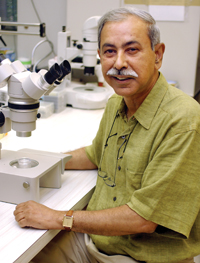
S.K. Dey, Ph.D., and colleagues are studying a molecule’s role in embryo implantation. (photo by Dana Johnson)
Tiny molecules aid embryo implantation
A complex, choreographed dance of molecular events is required for a developing embryo to take root safely in the mother's uterus.
In a new study, Vanderbilt University Medical Center researchers have identified molecules with a potential role in embryo implantation. In the early online edition of the Proceedings of the National Academy of Sciences, the investigators report that tiny bits of non-coding nucleic acids, called microRNAs, regulate the expression of genes key to implantation.
“Implantation is the gateway to a successful pregnancy,” said S.K. Dey, Ph.D., professor of Cell & Developmental Biology and Pharmacology and senior author on the paper. Dey's group previously showed that tightly controlled expression of the cyclooxygenase-2 (COX-2) enzyme in the uterine lining and the underlying stroma is critical for embryo implantation in mice.
COX-2 protein is required for synthesis of prostaglandins, agents that influence vascular permeability and new blood vessel growth. While increased vascular permeability is needed at the site of implantation, this process must be tightly regulated for implantation to be successful.
“You need regulated vascular permeability, so there must be a regulated amount of prostaglandin produced from COX-2,” said Dey. “If there is too much COX-2 activity, making too much prostaglandin, that would not be conducive to implantation.”
“We have shown that COX-2 is absolutely required for implantation,” he said. “But we didn't know how COX-2 is regulated in the uterus at the site of implantation.”
Dey postulated that a possible candidate for keeping this process in check was a class of molecules called microRNAs, which are short, non-coding sequences of ribonucleic acid (RNA), the nucleic acid that carries the “message” contained in DNA to the complexes where proteins are synthesized. However, these microRNAs are not translated into protein. Their function appears to be in regulating the expression of other genes — either by causing rapid breakdown of “messenger” RNA or by inhibiting its translation into protein.
One previous study, profiling microRNA expression in various tissues, showed that many microRNAs are highly expressed in human female reproductive tissues. In the new study, Dey's team analyzed the expression of 380 microRNAs in the mouse uterus. They found that more than two dozen microRNAs show differential expression in the receptive uterus during implantation.
They also found that two of these microRNAs — mmu-miR-101a and mmu-miR-199a* — were expressed at the same sites as COX-2. Their expression was inversely correlated to COX-2 protein levels; when COX-2 protein levels were high, microRNA expression level was low, and vice versa.
“So their main function seems to be to dampen COX-2 protein levels,” Dey explained.
The tight regulation of COX-2 activity in the receptive uterus goes awry in cancer. Dey and colleagues found a similar inverse relationship between COX-2 and microRNA expression in uterine and colon cancer cell lines.
“We see the same molecules [expressed] at the time of implantation and during cancer,” said Dey.
“But in implantation, they are highly regulated. In the case of cancer, they are dysregulated.”
In many cancers, COX-2 — and consequently, prostaglandins — are expressed at high levels, and increased prostaglandin levels stimulate the formation of new blood vessels that cancers need to survive and grow.
“I call this 'life and death connected by a common thread,'” he said. If further studies demonstrate that microRNAs can be manipulated to facilitate or inhibit implantation — or halt cancer — the molecules might represent promising leads for fertility regulation and uterine cancer therapies.
One potential hurdle in this field is that one microRNA can target many genes. Current estimates suggest that about 30 percent of the genes encoding proteins — almost all signaling pathways — may be regulated by microRNAs.
“It may not be only COX-2 — there may be many other genes involved at the site.
“So it needs to be carefully studied.”
In addition to previously described roles in cancer and viral infections, microRNAs now appear to play an important part in one of life's earliest landmark events. That's an impressive resume for molecules once considered among the non-coding “junk” of the genome.
With an ever-increasing number of functions being ascribed to non-coding DNA and RNA, Dey notes that “nothing is 'junk' anymore.”
Other authors included Anindita Chakrabarty, Ph.D., Susanne Tranguch, and Takiko Daikoku, Ph.D., from Vanderbilt and Kevin Jensen and Henry Furneaux, Ph.D., at the University of Connecticut Health Center. The research was supported by grants from the National Institutes of Health.
Dey is the Dorothy Overall Wells Professor of Pediatrics.













